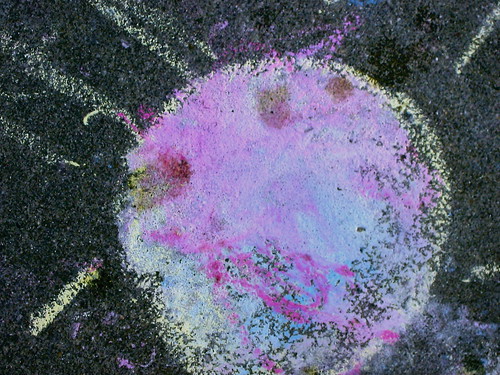
Moon
Viktor Shklovsky’s Zoo’s a disappointment: slack, bellying out with idle observations, one finds no reason to think “Alya”—Elsa Triolet née Kagan, Russian / French writer later married to Louis Aragon—worth the (too scantily ironic) sighing. I do like the report that “Marina Tsvetaeva says that Pasternak resembles both an Arab and his horse.” And, too, the report “how disarmingly amenable to everything” Andrei Bely is. How—in writing—“method,” an incomprehensible thing, inevitably emerges, even if one begins writing “as a joke”: “A man writing something big is like the driver whose 300-horsepower car dashes him against a wall—as if of its own volition.”
The report detailing the stunts at the Scala Theater on Lutherstrasse (Berlin) amused me a little—the spinning trapeze artists who apparently “turned into green vases,” the “repulsive man” who sank “teeth into the back of three or four heavy chairs that had been strapped together and lifted them off the floor,” the bicyclists who rear’d up on hind wheels and rode about “in no particular hurry, blowing, all of them, on trumpets.” Shklovsky: “Such a big program cannot be crammed into one sentence.” And the discontinuity of the theatrics points Shklovsky toward a thesis of seeing art as “a world of independently existing things.” “Words,” he says, “and the relationships between words, thoughts and the irony of thoughts, their divergence—these are the content of art. Art, if it can be compared to a window at all, is only a sketched window.” In that “thoughts and the irony of thoughts” one longs to see something akin to the Blakean “Without contraries is no progression,” or the Heraclitan “cooperate through opposition, and make a harmony of separate forces. Wholeness arises from distinct particulars; distinct particulars occur in wholeness” (Guy Davenport’s translation). And—out that “sketched window”—the William Carlos Williams clarity:
To transcribe the real creates, by the same act, an unreality, something besides the real which is its transcription, since the writing is one thing, what it transcribes another, the writing a fiction, necessarily so.I like Shklovsky’s idea of the “connective tissue”—what (historically) binds the “independently existing things” together—psychological motive, the hero, comic interludes. “When works of art are undergoing change, interest shifts to the connective tissue.” (What’s the connective tissue today? The impercipient smear of irony, the dumb’d-down repetitious little-girl-style talk (or little-boy), worn-out Marx-buzz, smarmy Debordist drifts of the inaccrochably leisured, archaickal mannerist hysteria? I don’t know—though I got my candidates. Likely something only retrospectedly identifiable.) What’s required (according to Shklovsky): no connective tissue, sheer weight of individual components. (Though he mentions a clown who “runs through all the acts, parodying and exposing them.” Eventual “baring the device” talk?)
The other Shklovsky-discern’d danger: becoming all connective tissue. The danger of art’s losing—pre-globally—“the local, the vital, the differentiated”: “art needs its own smell.”
Why the persistence of a supposed kinship between Shklovsky’s disdain for a long-nosed Hispano-Suiza automobile—“extremely dubious and forced”—and Guy Davenport’s insistence, by way of Heraclitus, on a plenum, a universe with no room for “connective tissue”? Shklovsky claims the Hispano-Suiza “uses its hood as a disguise: there is a space of almost two feet between the radiator and the engine . . . a lie made expressly for snobs; that two feet is a violation of good design.” He consigns the memory of “Alya” “to that void inside the Hispano-Suiza.” (“Tragic endings . . . are inevitable in an epistolary novel.”) Against which, tightly, one puts the stuff of Andre Furlani on Davenport: “Herakleitos intuits the universe as a plenum. This recommends the thinker to Davenport. ‘There is no nothing,’ he writes in a November 12, 2002 letter. ‘There couldn’t be.’” In the late story “The Owl of Minerva” one of Davenport’s precocious teenagers—mimicking a geologist uncle—asserts that science’ll finally make clear that “there’s no nothing, that the whole fucking clockworks is stuff, with the intervals between things a different kind of stuff that we poor ignoramuses call nothing.”
In the 1924 Preface to the Second Edition:
So many words are forbidden.In the next sentence, Shklovsky notes “an enormous, almost authentic moon”—a thing suddenly made heartbreakingly inexpressible.
. . . all the good words are faint with exhaustion.
Forbidden are flowers, the moon, eyes and whole rows of words telling how pleasant it is to see.
. . . I would like to write as if literature had never existed—for example, “Lovely is the Dnieper in quiet weather.”
I cannot; irony devours the words. It is needed, irony; it is the easiest way to overcome the difficulty of depicting things.
To depict the world as absurd is easiest of all.
Structuralisms/Structuralism/Shklovsky/Shklovsky2.jpg)